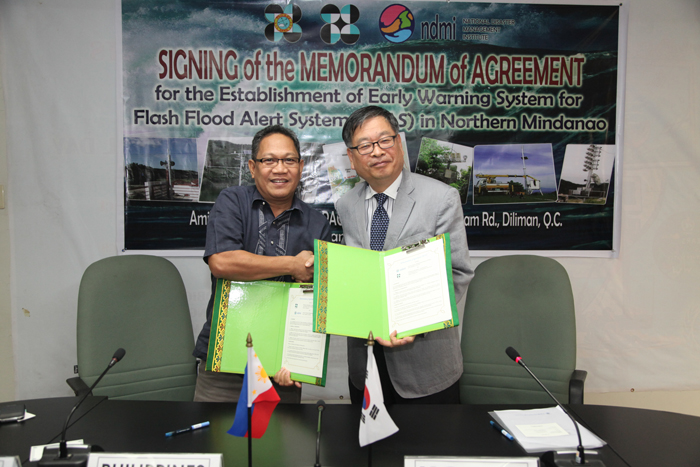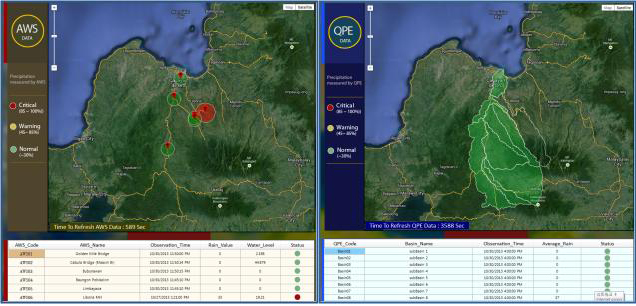Korea will help the Philippines build an early warning system to prevent damage from typhoons and floods.
Korea’s National Disaster Management Institute (NDMI) and the Philippine Atmospheric, Geophysical and Astronomical Services Administration (PAGASA) signed a memorandum of agreement (MOA) in Manila, the Philippines, on January 22. Under the agreement, the institute plans to analyze the country’s weaknesses in response to different types of disasters, such as floods, typhoons, avalanches, earthquakes and tsunamis, and provide disaster prevention know-how and technology.

The institute also presented new disaster prevention technologies to Philippine civil servants and discussed with the PAGASA the operation of a joint investigation team to study damage caused by Typhoon Haiyan in November 2013.
The Philippines has recently seen frequent occurrences of localized torrential rainfall and flash floods, believed to be aggravated by climate change. With increasing property damage and casualties caused by flash floods, the country came to see an urgent need to build an early warning system and a real-time monitoring and communication system.
As part of the NDMI’s project to supply new disaster prevention technologies, the institute is establishing an early warning system in the city of Cagayan de Oro, in the north of Mindanao Island, in order to minimize such damage. It is also training the country’s public servants involved in disaster prevention how to use a flash flood alert system and an automated rainfall warning system.

The NDMI’s project to supply new disaster prevention technologies began after the PAGASA requested Korea’s assistance in the establishment of a flash flood early warning system in the aftermath Typhoon Washi which caused enormous damage on Mindanao Island in December 2011.
“We will provide technologies for a flash flood early warning system and continue our technological support,” said Yeo Woon-kwang, president of the NDMI.
By Limb Jae-un
Korea.net Staff Writer
jun2@korea.kr

Korea’s National Disaster Management Institute (NDMI) and the Philippine Atmospheric, Geophysical and Astronomical Services Administration (PAGASA) signed a memorandum of agreement (MOA) in Manila, the Philippines, on January 22. Under the agreement, the institute plans to analyze the country’s weaknesses in response to different types of disasters, such as floods, typhoons, avalanches, earthquakes and tsunamis, and provide disaster prevention know-how and technology.

Yeo Woon-kwang (right), president of the NDMI, and Vincente B. Malano, administrator of the PAGASA, shake hands after signing the MOA in Manila, the Philippines, on January 22. (Photo courtesy of the NDMI)
The institute also presented new disaster prevention technologies to Philippine civil servants and discussed with the PAGASA the operation of a joint investigation team to study damage caused by Typhoon Haiyan in November 2013.
The Philippines has recently seen frequent occurrences of localized torrential rainfall and flash floods, believed to be aggravated by climate change. With increasing property damage and casualties caused by flash floods, the country came to see an urgent need to build an early warning system and a real-time monitoring and communication system.
As part of the NDMI’s project to supply new disaster prevention technologies, the institute is establishing an early warning system in the city of Cagayan de Oro, in the north of Mindanao Island, in order to minimize such damage. It is also training the country’s public servants involved in disaster prevention how to use a flash flood alert system and an automated rainfall warning system.

A screen capture of the flash flood alert system. It can predict the level of risk based on regional information and the amount of rainfall. (Photo courtesy of the NDMI)
The NDMI’s project to supply new disaster prevention technologies began after the PAGASA requested Korea’s assistance in the establishment of a flash flood early warning system in the aftermath Typhoon Washi which caused enormous damage on Mindanao Island in December 2011.
“We will provide technologies for a flash flood early warning system and continue our technological support,” said Yeo Woon-kwang, president of the NDMI.
By Limb Jae-un
Korea.net Staff Writer
jun2@korea.kr
